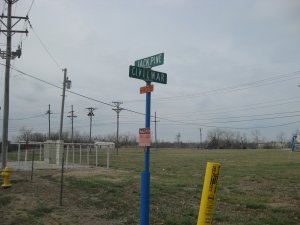


Directions: The Ordnuff Hill tour stop [ Waypoint = N37 11.693 W94 19.615 ] is located north of Carthage, Missouri 64836 on Civil War Avenue. It is about 2.8 miles from the previous tour stop.
Description: This stop on the tour places you on top of Ordnuff Hill (called Quarry Hill today) where Sigel posted a defensive line to protect his crossing the Spring River. Get out of your car and walk to the third Granite Historical Marker. It is located on the northeast corner of the intersection of Civil War Avenue and North Woods. You are now standing approximately where Sigel established a defensive line to protect his crossing of the Spring River as he continued his retreat to Carthage.

Federal Colonel Franz Sigel described the situation at Ordnuff Hill in his official report: [54]
The troops and baggage train crossed [Buck's Branch] creek, and retreated unmolested to the heights crowning the north side of Carthage before Spring River. Here they took position again. The enemy advanced slowly with his center, while he pushed forward his cavalry to turn our right and left, and to gain the Springfield road.

The Missouri State Guard Infantry continued to pursue Sigel's forces. By the time they reached Buck's Branch Creek, they could see that the wagons were on their way to Carthage. Sigel had set up his artillery batteries to protect the rear of his wagon train. Sigel's next key task in his retreat was getting across the ford into Carthage at Spring River. Just north of the Spring River ford, Sigel deployed his eight artillery guns on Ordnuff Hill covering his rear. The Federal Infantry would continue to escort the wagon train as it moved into Carthage. About an hour later the Missouri State Guard was approaching Ordnuff Hill. Sigel ordered his artillery to open fire. Once his wagon train had safely crossed the Spring River, Sigel began to disengage from Ordnuff Hill. [55]



Brigadier-General James Rains described the pursuit of Sigel by the Missouri State Guard in his official report: [56]
Colonel Sigel again commenced a retrograde movement, and retreated across a prairie 5 miles to Spring River, closely followed by the infantry and artillery. The cavalry under my command, joined by a regiment of General Slack's division, commanded by Colonel Rives, endeavored to outflank them on the right, but the retreat was so rapid as to defeat our object. On nearing Spring River we attempted to intercept the enemy's crossing, but they again opened a heavy and destructive fire from their artillery, which compelled us to take a crossing higher up, and, pushing forward, endeavored to surround the town.